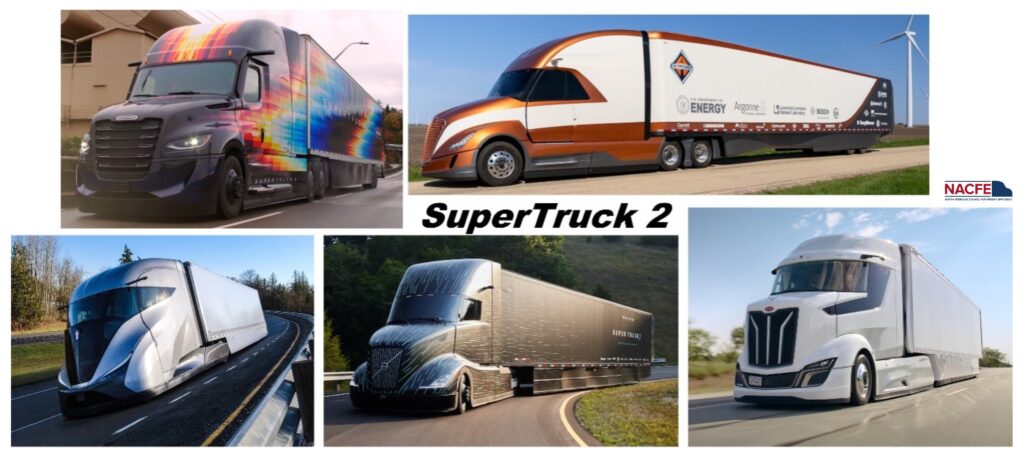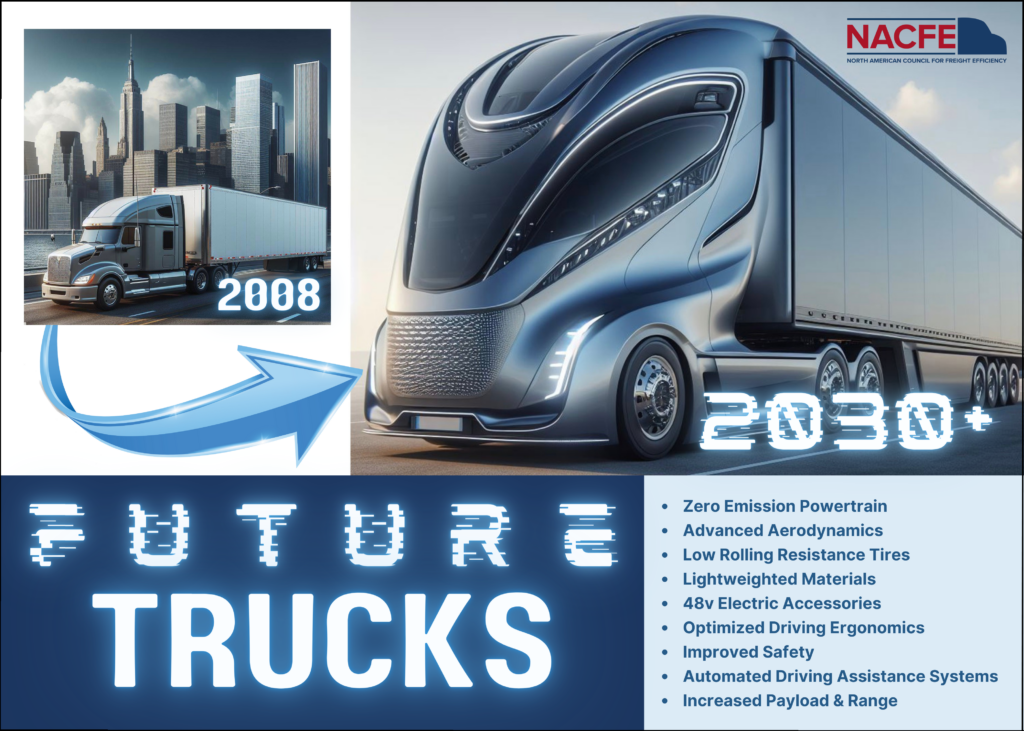SuperTruck 2: Empowering Future Trucking
In 2009, the U.S. Department of Energy (DOE) inspired American truck manufacturers by funding the first SuperTruck project to demonstrate a system of new technologies with the goal of greatly improving freight energy efficiency, reducing vehicle operating costs and improving environmental sustainability. The hugely successful demonstrations led to DOE funding the even more aggressive SuperTruck 2 program beginning in 2016.

The SuperTruck 2 opportunity to harness the creativity of OEMs and suppliers to push the envelope of vehicle design was embraced by five teams lead by:
- Cummins Inc. & Peterbilt
- Daimler Truck North America (DTNA)
- Volvo Trucks
- Navistar
- PACCAR Inc.
Video to Come
From 2016 through 2024, each of these five teams succeeded in innovating complete tractor-trailer systems capable of exceeding freight efficiency performance improvements of more than 100% versus each team’s Model Year 2009 baseline diesel tractors with standard 53’ dry van box trailers. These accomplishments created a watershed of practical engineering and operational information to assist in developing production tractors and trailers to meet the increasingly demanding performance needs of the North American freight industry.
The fundamental basis of these SuperTruck 2 demonstrations is that a systems engineering perspective, encompassing the entire tractor-trailer as a single performing unit, can yield significantly better performance improvements than more piecemeal approaches looking at optimizing individual systems.
SuperTruck 2 teams had essentially two goals. One was to demonstrate a 55% brake thermal efficiency (BTE) engine in an engine test stand. The second was to demonstrate a complete tractor-trailer vehicle system that exceeded a 100% improvement in freight-ton-efficiency (FTE) versus their selected MY2009 baseline vehicle with a gross vehicle weight of 65,000 lbs. in a representative on-highway long-haul duty cycle of their own choosing.
Conclusions
- Fuel Economy Improvement: SuperTruck 1 vehicles demonstrated MPGs in the range of 11 to 13 MPG and FTEs greatly exceeding their target 50% improvement versus their MY2009 baseline. The SuperTruck 2 technologies had a target of exceeding 100% versus those same baselines and MPGs as much as 16 MPG by further optimizing diesel technologies, and incorporating 48V mild hybridization and in one case, full high-voltage hybridization. NACFE estimates the equivalent MPG for the emerging battery electric vehicles is starting at 18.5 MPGe. The performance of the SuperTruck 2 demonstrations shows there are significant efficiency gains remaining for diesel-powered vehicles, but it also highlights the complexity required to achieve those gains. SuperTruck 3 and also the associated hydrogen programs are innovation solutions for battery electric and fuel cell medium- and heavy-duty trucks in development over the next five years, hopefully with prototype vehicles seen in public as early as 2026.
- Innovation Diffusion: Trucks that exist as ideas, what NACFE terms “paper trucks,” are part of the research and development process, but they are easily debated as they largely lack real-world testing. The SuperTruck vehicles are real-world trucks evaluated strenuously by expert teams that have skin in the game with their own money, resources and reputations along with funding from the government. Teams often include participants not typically allowed behind the wall of proprietary development at OEMs including national laboratories and university researchers. Potentially excellent ideas that normally sit on shelves from lack of management engagement or interest can make it into full system development of vehicles. Development perspectives that may be hamstrung with component-level development are set free to bloom by participating in a complete vehicle system perspective where, for example, performance gains in one area are achieved by weight reductions or simplification in completely unrelated areas of the vehicle. SuperTruck projects empower designers to literally think outside the mental boxes they typically must work within under normal organizational product development.
- Universal Ideas: Many tractor-trailer system efficiency gains are universally applicable to all powertrain choices. Reducing the energy required to move freight over a distance means less operational cost. Another way to view that is that less energy required per mile can translate into greater net range for the same amount of energy, and/or greater payload. Improving the tractor-trailer as a system is a key perspective to help emerging zero-emission vehicles to achieve more miles per fill-up. Future trucks will build from technologies demonstrated in SuperTruck 2 to achieve increased range and freight capacity. For example, a 100% improvement in MPG easily demonstrated by SuperTruck 2 teams would make a 300-mile BEV capable of going 600 miles.
